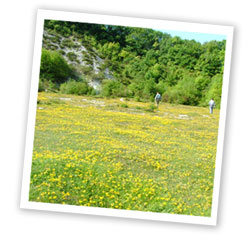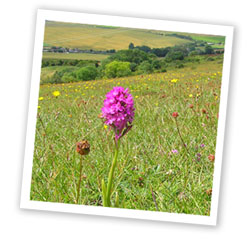|
|
Grassland & Heathland
Find out more
One of the most visible and well-known Isle of Wight habitats, the downs shelter many vulnerable species and are also cherished landscapes for visitors and locals alike.Habitat Action Plans
Grazing
and Grassland Management Topic Report (2002)
Calcareous
Grassland HAP (2002)
Heathland
and Acid Grassland HAP (2002)
Lowland Meadows HAP (2008)
Key Sites
Compton Down
West High Down
Mottistone Down
Ventnor Downs
Arreton Down
Bembridge Down
Calbourne Down
Garstons Down
Rew Down
Shide Qaurry
Prospect Quarry
Knighton Down
Brighstone Down
The most distinctive ecological characteristic of the Isle of Wight's downs is the community of plants and animals which have grown up on the chalk grasses found there. Although other types of habitat are often found on the downs, for example farmland or woodland, it is the chalk grassland which is the most visually important in the landscape, ands which includes some of the most specialised and rare habitat and species.
Chalk
grassland
Chalk (calcareous) grassland is one of the richest and most distinctive wildlife habitats in this country. The calcareous grasslands of the Island range from those of European importance for their plants, through those of national significance, to those of importance for the local biodiversity of the Island. Many species of plants and invertebrates are restricted to this habitat and are sensitive to grazing management. Much of the chalk grassland, particularly in West Wight, is similar to that of Purbeck in Dorset, to the west.

 A particular
feature is the influence of the coast which has given rise to extensive maritime
chalk cliffs and cliff top grassland supporting populations of several nationally
rare and scarce plants and invertebrates. A strong maritime influence on
the south facing slopes at the western end of the Island has resulted in
a distinctive grassland community. There are also important fragments of
rich lichen communities. Scrub can be a prominent feature on some sites,
and species-rich scrub / grassland mosaics can result in increased plant
and animal diversity, particularly benefiting invertebrates, but this requires
careful balanced management to retain the interest. The downs in the west
Wight are often capped with clay with flint deposits supporting gorse scrub,
and in a few places, a chalk heath community.
A particular
feature is the influence of the coast which has given rise to extensive maritime
chalk cliffs and cliff top grassland supporting populations of several nationally
rare and scarce plants and invertebrates. A strong maritime influence on
the south facing slopes at the western end of the Island has resulted in
a distinctive grassland community. There are also important fragments of
rich lichen communities. Scrub can be a prominent feature on some sites,
and species-rich scrub / grassland mosaics can result in increased plant
and animal diversity, particularly benefiting invertebrates, but this requires
careful balanced management to retain the interest. The downs in the west
Wight are often capped with clay with flint deposits supporting gorse scrub,
and in a few places, a chalk heath community.
| home | partnership | habitats | species | biodiversity opportunity areas | benefits of biodiversity |
biodiversity & you | advice | walks & events | library | contact |